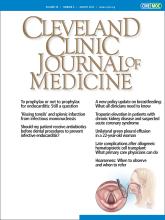To the Editor: In the June issue, Jaroenpuntaruk et al1 described the early diagnosis and management of severe drug eruptions. We have several suggestions for this review.
First, the subtypes of severe drug eruptions usually include Stevens-Johnson syndrome/toxic epidermal necrolysis, drug reaction with eosinophilia and systemic symptoms, and acute generalized exanthematous pustulosis (AGEP), but not drug-induced vasculitis.2,3 As noted in the article, drug-induced vasculitis is usually a small-vessel vasculitis and is limited to cutaneous vasculitis and arthralgia. Severe multiple-organ involvement is rare.
The authors also pointed out that skin biopsy is the gold standard for diagnosing severe drug eruptions. It is certainly not the gold standard, although pathology plays a role in the diagnosis and differential diagnosis of drug eruptions. Pathologic clues of drug eruptions include apoptotic keratinocytes, eosinophils within the inflammatory infiltrate, papillary edema, and vascular changes. However, these are nonspecific. The diagnosis of severe drug eruptions lacks specific tests and relies on a comprehensive analysis of the clinical presentation, history, and laboratory findings.2,3
Finally, it is inappropriate to recommend dermoscopy for AGEP due to a lack of valid evidence. Only 1 case report has mentioned that dermoscopy could help visualize pustules and was useful in distinguishing AGEP from morbilliform drug eruption.4 It is not difficult to observe pustules with the naked eye in most cases. Furthermore, dermoscopy does not distinguish AGEP from other pustular skin conditions such as pustular psoriasis, subcorneal pustulosis, and pustular vasculitis. Dermoscopy is of limited value in the diagnosis and grouping of drug eruptions.
Identification of a potential culprit drug is complicated by the fact that patients usually use several drugs simultaneously. Patch testing is a safe and practical technique. The utility of testing may vary on the specific drug and the subtypes of drug eruptions.5 Neither the prick test nor the intradermal test is recommended, although the intradermal test is more sensitive than the prick test, and an oral drug-provocation test is prohibited due to the risk of relapse.2
- Copyright © 2023 The Cleveland Clinic Foundation. All Rights Reserved.






